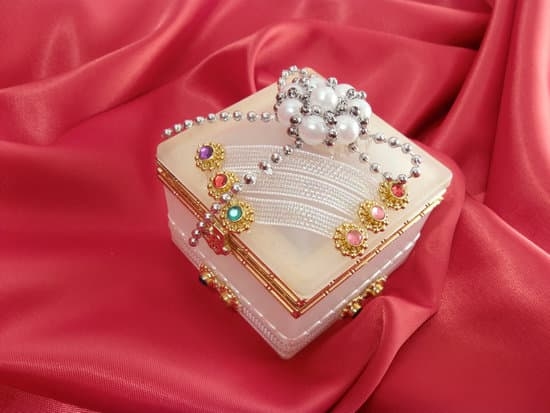Can you glue beads onto jewelry wire to create stunning and unique pieces? The answer is yes, and it’s a popular technique in the world of jewelry making.
Gluing beads onto jewelry wire allows for endless possibilities in design and style, making it a preferred method for many jewelry artisans. In this article, we will explore the importance of using the right glue, choosing the correct beads and wire, preparation and set-up, gluing techniques, tips for avoiding common mistakes, finishing and securing the beads, as well as maintenance and care for your glued bead jewelry.
When it comes to gluing beads onto jewelry wire, using the right type of glue is crucial for ensuring longevity and durability. In the following sections, we will discuss why choosing the correct adhesive is essential in creating high-quality jewelry pieces that stand the test of time. Additionally, we will also provide insights into selecting the right materials such as beads and wire to achieve professional results.
In order to successfully glue beads onto jewelry wire, proper preparation and set-up are key. We will guide you through step-by-step instructions on how to prepare your materials and work area before starting your project. By following these guidelines, you can ensure a smooth and efficient process for attaching your beads securely onto the wire.
Importance of Using the Right Glue
When it comes to gluing beads onto jewelry wire, using the right type of glue is crucial for ensuring the longevity and durability of the finished piece. The type of glue you use can make a significant difference in how well the beads adhere to the wire and how secure they are over time.
Using the wrong type of glue can lead to beads coming loose or falling off, which can be frustrating after putting time and effort into creating a beautiful piece of jewelry.
Choosing the Right Glue
Not all glues are created equal when it comes to jewelry making. It’s important to choose a glue that is specifically designed for adhering beads onto metal, such as jewelry wire. Look for adhesives that are strong, waterproof, and suitable for use with both metal and other materials like glass, crystal, or gemstone beads. Additionally, consider factors like drying time and flexibility once cured, as these will impact the overall quality and durability of your project.
Benefits of Using the Correct Glue
Using the right type of glue for adhering beads onto jewelry wire offers several benefits. Firstly, it ensures a strong bond between the beads and wire, preventing them from coming loose with regular wear. Secondly, high-quality adhesives provide long-lasting durability, reducing the likelihood of repairs or replacements in the future. Lastly, using the correct glue can contribute to achieving a professional-looking finish on your jewelry pieces.
By understanding the importance of using the right glue for securing beads onto jewelry wire, you can enhance the overall quality and longevity of your handmade jewelry pieces. Taking the time to select an appropriate adhesive will ultimately contribute to creating stunning and durable designs that will stand the test of time.
Choosing the Right Beads and Wire
When it comes to choosing beads and wire for a jewelry project, it’s essential to consider the specific requirements of gluing beads onto wire. Not all beads and wire are suitable for this technique, so it’s crucial to select the right materials to ensure a successful outcome. Here are some factors to consider when choosing beads and wire for your gluing project:
Types of Beads
There are various types of beads available, including glass, crystal, plastic, metal, and gemstone beads. When selecting beads for your project, consider the size, weight, and shape of the beads. It’s important to choose beads that are lightweight enough to be securely glued onto the wire without causing strain or breakage.
Types of Wire
The type of wire you choose for your project will also have a significant impact on the success of gluing beads onto it. You can use various types of wire for jewelry making, such as sterling silver, copper, gold-filled, or craft wire. When selecting wire for gluing beads, consider the thickness and flexibility of the wire. Thinner wires may be more suitable for delicate beadwork, while thicker wires can provide sturdier support for heavier beads.
Tips for Selecting Materials
When choosing beads and wire for your project, it’s essential to visualize how they will look when combined. Consider the color scheme, texture, and overall design aesthetic you want to achieve with your jewelry piece. Additionally, ensure that the adhesive you plan to use is compatible with both the beads and the wire material.
By carefully considering these factors when choosing beads and wire for your jewelry project, you can ensure that they are well-suited for gluing and will result in a durable and beautiful finished piece. Can you glue beads onto jewelry wire? Absolutely. With the right materials and techniques in place, you can create stunning jewelry pieces by adhering beads onto jewelry wire effectively.
Preparation and Set-Up
Before you start gluing beads onto jewelry wire, it’s important to properly prepare your materials and work area to ensure a successful outcome. Here is a step-by-step guide on how to prepare the beads, wire, and work area before gluing:
1. Choose the right beads and wire: Select the beads and jewelry wire that are suitable for gluing. Ensure that the beads have a flat surface or hole that can be easily glued onto the wire without slipping off.
2. Clean and dry your materials: Before you begin gluing, make sure to clean both the beads and wire with a mild detergent and water. This will remove any dirt or residue that could affect the adhesion of the glue.
3. Organize your work area: Set up a clean and well-lit workspace where you can comfortably work on your jewelry project. Lay down a protective sheet or cloth to prevent any damage to your work surface.
4. Arrange your materials: Lay out all of your beads and wire in an organized manner so they are easily accessible while you work. This will help prevent any interruptions during the gluing process.
5. Gather the necessary tools: Have all of your tools such as toothpicks, small brushes, and the correct type of glue handy so that you don’t need to interrupt your work once you start gluing.
By following these preparation steps, you can ensure that your materials are ready for gluing, and create an ideal environment for a successful outcome when adhering beads onto jewelry wire.
Can you glue beads onto jewelry wire? Yes. by following these steps in preparing both materials then using proper tools like toothpick or brush while utilizing appropriate adhesive helps maintain longevity for this technique in jewelry making industry.
Gluing Techniques
When it comes to gluing beads onto jewelry wire, using the right technique for applying glue is crucial to ensure a secure and long-lasting attachment. There are various methods that can be used to apply glue to beads and wire, each with its own advantages.
Whether you are using a toothpick, small brush, or any other application tool, it is important to choose the method that best suits the size and shape of the beads, as well as the type of wire being used.
Here are some popular gluing techniques for attaching beads onto jewelry wire:
- Using a Toothpick: One of the most common methods for applying glue to small beads is by using a toothpick. Simply dip the tip of the toothpick into the glue and carefully apply it to the bead’s hole or surface. This allows for precise application and minimizes excess glue, resulting in a neat and professional finish.
- Small Brush Application: For larger beads or areas that require more coverage, using a small brush can be an effective method for applying glue. A tiny paintbrush or detailing brush can help evenly distribute the adhesive onto the bead’s surface or along the length of the wire before attaching the beads.
- Squeeze Bottle with Fine Tip: Another option is to use a squeeze bottle with a fine tip nozzle, which allows for controlled dispensing of glue onto both beads and wire. This method is particularly useful when working with delicate or intricate designs that require precision in gluing.
By choosing the right gluing technique for your specific project, you can ensure that the beads are securely attached to the jewelry wire without any mess or mishaps. It also allows for greater control over how much adhesive is applied, resulting in a professional and polished look for your handmade jewelry pieces.
Tips for Avoiding Common Mistakes
Gluing beads onto jewelry wire is a popular technique in jewelry making, as it allows for endless creativity and design possibilities. However, to achieve a professional and long-lasting result, it is essential to avoid common mistakes when applying the glue to the beads and wire.
One common mistake to avoid is using too much or too little glue. Using too much adhesive can create a messy and unattractive finish, while using too little may result in the beads not adhering securely to the wire.
To prevent these mishaps, it is important to use the correct type of glue that is specifically designed for jewelry making. Jewelry glue, such as E6000 or super glue, is recommended for attaching beads onto wire due to its strong bonding properties and ability to withstand regular wear. Additionally, when applying the glue, it’s best to use a toothpick or small brush to control the amount and ensure precise application.
Another common mistake when gluing beads onto jewelry wire is failing to properly prepare the materials and work area. Before starting the gluing process, it’s important to clean the beads and wire to remove any oil or dirt that could interfere with adhesion. Additionally, setting up a designated work area with proper ventilation can help ensure successful gluing without inhaling harmful fumes from strong adhesives.
Finally, securing the beads onto the wire after gluing is crucial for achieving a professional finish. Once the glue has dried, gently tug on each bead to ensure it is firmly attached. If any beads feel loose, reapply a small amount of glue and allow it to dry completely before handling the jewelry piece again.
| Common Mistake | Solution |
|---|---|
| Using Too Much Glue | Use a toothpick or small brush for precise application |
| Using Too Little Glue | Ensure proper amount of adhesive ensures secure attachment |
| Failing To Properly Prepare Materials And Work Area | Clean materials thoroughly before gluing; Set up designated work area with proper ventilation for successful gluing process |
By avoiding these common mistakes and following best practices for gluing beads onto jewelry wire, you can create stunning pieces that are not only beautiful but also durable and long-lasting. With careful preparation, attention to detail in application techniques, and proper finishing methods, your beaded jewelry pieces can become cherished accessories that will stand the test of time.
Finishing and Securing the Beads
One way to secure the beads onto the wire after gluing is by using crimp beads. Crimp beads are small metal beads that can be flattened with pliers to hold the wire and beads in place. After stringing your beads onto the wire, you can add a crimp bead, then thread the end of the wire back through it before flattening it with crimping pliers. This creates a secure loop that holds everything in place.
Another method for securing beads onto jewelry wire after gluing is by creating wrapped loops at each end of the bead section. To do this, use round-nose pliers to create a 90-degree bend in the wire just above the last bead. Then, use your fingers or chain-nose pliers to wrap the excess wire around itself to form a loop, ensuring that it is tight and secure.
It’s important to note that when finishing and securing beads onto jewelry wire after gluing, you should ensure that each bead is tightly connected to avoid any gaps or looseness in your design. Properly secured beads will enhance both the appearance and durability of your handmade jewelry piece.
| Securing Method | Description |
|---|---|
| Crimp Beads | Small metal beads flattened with pliers to hold wire and beads in place. |
| Wrapped Loops | Bending and wrapping excess wire around itself to form a tight loop at each end of the bead section. |
Maintenance and Care
In conclusion, gluing beads onto jewelry wire is a popular and effective technique in jewelry making. However, it is crucial to use the right type of glue to ensure the longevity and durability of the finished piece. Using the correct materials, such as suitable beads and wire, and preparing the work area properly are also essential for a successful outcome.
When it comes to maintenance and care for jewelry pieces made with glued beads and wire, there are a few tips to keep in mind. Firstly, it is important to handle the jewelry with care and avoid any rough or forceful handling that could dislodge the beads.
Additionally, storing the jewelry pieces in a safe and secure manner can prevent damage or breakage. It is also recommended to clean the jewelry regularly using mild soap and water to remove any dirt or residue that may accumulate over time.
Ultimately, with proper care and maintenance, jewelry pieces made with glued beads and wire can last a long time without losing their beauty or integrity. By following these tips, jewelry enthusiasts can enjoy their handmade creations for years to come.
Frequently Asked Questions
How Do You Get Beads to Stay on Wire?
To get beads to stay on wire, you can use crimp beads or tubes. Simply slide the crimp bead onto the wire, add your beads, then loop the end of the wire back through the crimp bead and flatten it with pliers.
What Kind of Glue Do You Use for Beads?
When it comes to using glue for beads, a clear jewelry adhesive or E6000 adhesive are great options. These types of glue provide a strong bond and dry clear, which is important for maintaining the overall appearance of the beaded jewelry.
What Kind of Glue to Use for Jewelry?
For making jewelry, it’s best to use a jewelry-specific glue like E6000 or G-S Hypo cement. These types of glues are designed to work with various materials commonly used in jewelry making such as metal, glass, and stones. They provide a strong and reliable bond without damaging the materials.

Welcome to my jewelry blog! My name is Sarah and I am the owner of this blog.
I love making jewelry and sharing my creations with others.
So whether you’re someone who loves wearing jewelry yourself or simply enjoys learning about it, be sure to check out my blog for insightful posts on everything related to this exciting topic!





